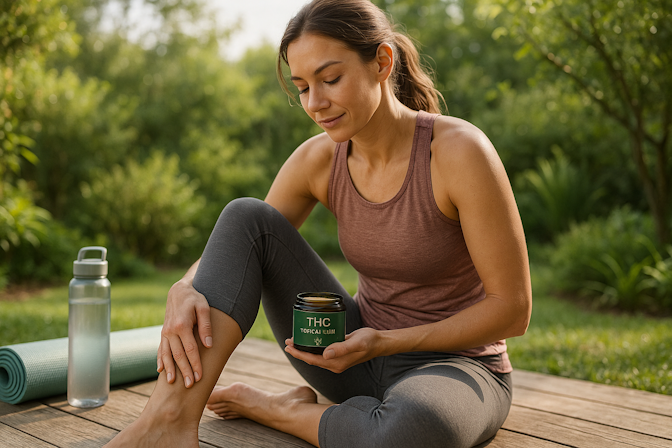
Herb
Are THC Topicals a Scam? What Science Actually Says
The truth about THC topicals and skin absorption.
THC topicals are everywhere these days, from sleek glass jars of cannabis creams to bath bombs promising spa-like pain relief. These products claim to deliver localized benefits without the high, appealing to consumers who want the potential health benefits of cannabis without the intoxicating effects that come with cannabis when it is smoked or ingested.
But as with many trends in medical cannabis, the buzz sometimes gets ahead of the research. Can THC topicals really offer meaningful benefits, or are they mainly another wellness trend? Let’s take a closer look at what the science says and what remains unproven.
What Are THC Topicals?

Herb
THC topicals are products such as lotions, creams, balms, oils, bath bombs, and transdermal patches, designed for direct application to the skin.
Unlike ingested or inhaled cannabis, these products interact with the skin and the endocannabinoid system, engaging local pathways that may influence pain, inflammation, or skin conditions, without causing a full-body psychoactive effect. Many consumers use THC topicals for arthritis, muscle soreness, or skin issues like eczema or psoriasis.
Cannabis topicals can work in different ways depending on the product being used. Some are formulated for surface-level application, while others aim for deeper tissue effects or systemic absorption. Understanding these differences can help you select the best topical product for your specific needs.
THC Creams, Balms, and Lotions

leighann blackwood / unsplash
These are the most common types of THC topicals you’ll find on dispensary shelves. They’re generally designed to provide localized relief by interacting with cannabinoid receptors in the skin. Many are marketed for pain relief, arthritis, or post-exercise muscle recovery.
The texture and ingredients can vary widely; balms tend to be thicker and oil-based, while THC lotions and creams are often lighter in consistency. Some brands even produce and sell cannabis-infused lip balms.
Transdermal Patches

herb
Unlike traditional topical application, transdermal patches are designed to deliver THC (and often CBD) through the skin barrier and into the bloodstream. These products utilize specialized carrier ingredients or penetration enhancers to penetrate the outer layers of the skin.
As a result, they can provide pain relief over a sustained period and may produce psychoactive effects, depending on dose and formulation. If you’re looking for steady, systemic delivery, this is where transdermal options stand apart.
Oils and Serums

ransford quaye / unsplash
THC oils and serums are often marketed for skin conditions like eczema, psoriasis, or general skin wellness. They typically contain cannabinoids along with other plant oils and essential oils to nourish the skin. Some are designed for massage or broad skin application, while others are formulated for smaller, more targeted areas.
Bath Bombs

Eir Health / unsplash
THC-infused bath bombs provide a unique experience. Rather than targeting a single affected area, they expose the entire skin surface to THC, CBD, and other botanicals while you soak. This allows for more widespread skin absorption, which may help relax muscles and alleviate tension throughout the entire body.
While most bath bomb formulations aren’t optimized for significant bloodstream absorption, prolonged warm water exposure may enhance how cannabinoids interact with skin receptors. These products typically don’t cause a high, but they may help support relaxation and muscle comfort.
How Topical THC is Supposed to Work

Ana Azuria / Unsplash
Beneath the surface of your skin is a network of receptors and signaling systems that may help explain how topical THC application works.
The skin naturally contains cannabinoid receptors, specifically CB1 and CB2, which are found on nerve fibers, immune cells, and skin cells. When activated, like by THC topicals, these receptors may help reduce pain sensitivity, calm inflammation, and support the skin’s natural healing processes.
THC also interacts with other receptors involved in pain and inflammation, like TRPV1, which plays a crucial role in how the skin senses pain, itch, and heat. Topicals may be even more effective in alleviating pain and inflammation when CBD is included. CBD has been shown to enhance the activity of specific receptors, including adenosine A2A receptors, which can help reduce inflammation in surrounding tissues.
All of this suggests that topical cannabinoids may influence multiple pathways in the skin simultaneously. This potentially explains why many consumers find them helpful for pain relief, skin conditions, and localized treatment.
That being said, how well a cannabis topical works can depend on several factors, including:
- Dosage taken
- Other ingredients present in the topical
- How well the formula is designed to help THC and CBD penetrate the skin
More research is still needed to understand which formulations are most effective and for whom.
Marketing Claims and Advertised Benefits of THC Topicals

sia ray / unsplash
If you browse product labels and websites for THC topicals, you’ll find no shortage of enticing language. Many brands promote these products as natural tools for managing pain, easing inflammation, and improving skin health, offering a soothing alternative to smoking or ingesting THC.
Pain relief and inflammation reduction are the most commonly promoted benefits. Products like cannabis creams, balms, and lotions often target consumers dealing with sore muscles, joint stiffness, or general discomfort. Fitness enthusiasts are a key audience too, with brands positioning THC topicals as aids for post-workout recovery and athletic performance.
Another fast-growing market is skincare, as some marijuana topicals are marketed for conditions such as eczema, psoriasis, or acne. These claims often reference anti-inflammatory properties observed in preclinical studies of THC and CBD applied to the skin. While preclinical research suggests potential benefits of using cannabinoids in skin conditions, clinical evidence for many of these uses remains limited.
It’s important to note that cannabis companies are not legally permitted to make medical claims about their products. This means they technically cannot claim to treat, cure, or prevent any disease. So, approach product marketing with a critical eye and recognize that the science on cannabis topicals is still evolving.
The Science: Does Topical THC Get Absorbed Into the Bloodstream?

herb
One of the biggest questions around THC topicals is: Does topical THC get absorbed into the bloodstream? The answer depends heavily on the type of product being used.
Standard topical application of THC via creams, lotions, or balms typically results in localized relief with no systemic absorption. The outermost layer of the skin, the stratum corneum, acts as a strong barrier that limits the penetration of most compounds, including cannabinoids.
However, transdermal patches are an exception. These are specifically designed to overcome the skin barrier using permeation enhancers. As a result, THC from these patches can enter circulation, potentially causing psychoactive effects and systemic actions. For consumers seeking localized relief without the high, sticking to traditional cannabis topicals is the safer bet.
THC Topicals for Pain Relief: What the Research Shows

herb
Most of the scientific studies supporting topical cannabis and pain relief are preclinical, meaning they’ve been conducted on animals, not humans. A 2022 review found that many animal studies show THC and CBD can reduce pain and inflammation when applied to the skin by interacting with local cannabinoid receptors.
With human studies, the evidence is less robust but growing. As noted by several studies, topical applications of THC or CBD may improve pain outcomes for certain conditions like arthritis and peripheral neuropathy. For example, patients with arthritis who used CBD creams reported reductions in pain and improved joint function in early studies.
In short, there is some scientific rationale and early human data supporting the use of THC and CBD topicals for pain relief. But the clinical trials are still in their infancy. We need larger, more rigorous studies to fully understand the effectiveness of these products, the impact of dosage and cannabinoid formulation on outcomes, and which patient populations are most likely to benefit from them.
CBD Pain Topical with THC: The Entourage Effect Question

Bee Naturalles / Unsplash
One of the more intriguing product categories is the CBD pain topical with THC. These formulations are marketed as leveraging the “entourage effect,” the idea that THC and CBD, along with other cannabinoids, work synergistically to enhance therapeutic benefits.
While the entourage effect is better studied in ingested or inhaled cannabis, emerging research suggests that CBD and THC may also interact beneficially in topical use. Combining CBD’s potent anti-inflammatory properties with THC’s analgesic potential may offer a broader range of action, particularly for pain relief and skin conditions.
Still, this remains an area where more clinical research is needed. For now, a well-formulated CBD topical with THC may be a good option for consumers seeking a multi-targeted approach.
THC Topical Side Effects

Romina Farias / Unsplash
The most common THC topical side effects are skin irritation and allergic reactions. Certain users may experience redness, itching, or a rash, often due to additives such as essential oils or preservatives, rather than the cannabinoids themselves.
Serious adverse events are rare but possible, especially for individuals with highly sensitive skin or underlying autoimmune conditions. There is also a theoretical risk of drug interactions, especially when using transdermal patches that deliver THC systemically, which raises questions about whether it’s safe to mix cannabis with OTC medications.
Long-term safety data for chronic topical cannabis use are still lacking. Medical doctors recommend avoiding THC products during pregnancy and breastfeeding due to limited evidence on fetal or infant exposure. Except for transdermal products, cannabis topicals do not enter the bloodstream and are unlikely to pose a risk during pregnancy.
The Verdict: Scam or Legitimate Treatment?

nora topicals / unsplash
So, where does all this leave us? The market for THC topicals is full of exciting claims, but how much of it holds up under scientific scrutiny?
While topical cannabis products may offer real pain relief and anti-inflammatory effects for some, the overall evidence is still a work in progress.
What We Know vs. What We Don't Know
Here’s where the evidence stands: THC topicals do appear to engage cannabinoid receptors in the skin and may offer localized relief for pain and inflammation. Early research and anecdotal reports are encouraging, particularly for conditions such as arthritis, neuropathy, and skin conditions like eczema and acne.
However, large-scale clinical trials are lacking, and many consumer products remain clinically untested. Claims about reversing major skin diseases, providing deep tissue relief, or other medical claims should be viewed with caution until stronger data emerge.
Making an Informed Decision
If you’re curious about THC topicals, start small and approach them systematically. Choose well-tested products from reputable brands and test them on a small patch of skin to check for potential skin irritation. Track your response over several uses and avoid products making sweeping, unsupported medical claims.
For individuals with serious or chronic conditions, consulting a trusted healthcare provider first is the safest course of action. Like many areas of medical cannabis, topical THC holds exciting potential, but it pays to stay informed, skeptical, and mindful as this field continues to evolve.
Herb Recommended Products:
READ MORE










